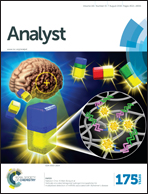Mercury species induced frequency-shift of molecular orientational transformation based on SERS†
Abstract
We proposed a novel readout method based on a peculiar phenomenon in which the vibrational frequencies of a SERS-active probe (dimethyldithiocarbamic acid sodium salt, DASS) can be affected when there is mercury species. Compared to the SERS intensity-dependent quantitative determination method, SERS frequency-shift-based methods have several advantages: smaller standard deviation, perfect linear relationship, and higher accuracy and sensitivity. In addition, the SERS frequency-shift-based method was not affected by irreproducible aggregation of the SERS substrate and instrumental factors, which greatly improved the application prospect of SERS-based detection. The DASS-modified silver nanoparticles produced a highly sensitive sensor specific to mercury species. Upon the addition of a solution of mercury species to the chip, the mercury species specifically binds to the sulfur atoms, which induces a frequency shift of the band at 1374 cm−1. The detection limit of the proposed method for Hg2+ is as low as 10−8 M. In addition, the proposed method exhibited the same phenomenon for organic mercury. Moreover, these results suggest that the proposed platform possesses the potential for sensitive, selective, and high-throughput on-site mercury pollution monitoring in resource-constrained settings.


 Please wait while we load your content...
Please wait while we load your content...